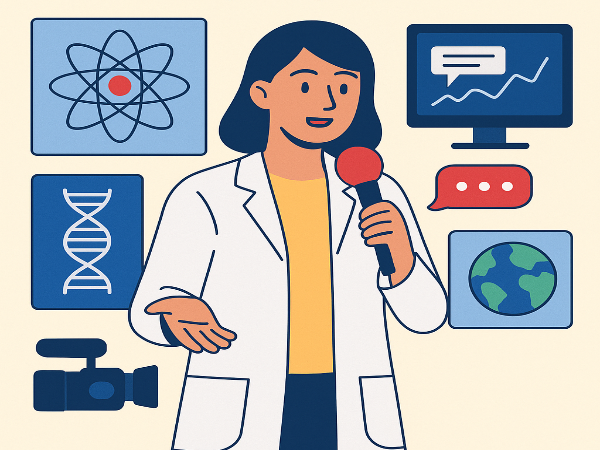Science Communication Jobs: Your Complete Guide to a Future of Storytelling in Science
Discover How to Turn Your Passion for Science Into a Meaningful Career Bridging Knowledge and Society

Science communication jobs connect scientists, institutions, and the public by translating complex scientific ideas into clear, engaging stories. These roles span writing, media, education, policy, and digital outreach—helping make research understandable and impactful. Whether you’re a scientist who loves storytelling or a communicator drawn to science, science communication jobs offer a unique and rewarding career path at the intersection of knowledge, creativity, and public engagement.
What Are Science Communication Jobs?
Science communication jobs are professional roles dedicated to making scientific knowledge accessible, accurate, and engaging for audiences beyond the research community. In simple terms, science communicators bridge the gap between scientific discovery and public understanding. They help shape how the world perceives science — from climate change and health to space exploration and technology.
These professionals work across multiple industries including universities, research institutes, government agencies, NGOs, news organizations, science museums, pharmaceutical companies, and digital media platforms. Their mission is to explain what scientists do, why it matters, and how it impacts society — all in a way that inspires curiosity and trust.
Science communication is not limited to one format. It can involve writing articles, producing videos, creating social media campaigns, organizing exhibitions, or speaking directly to communities. In every case, the communicator serves as a translator between technical language and public understanding.
Why Science Communication Matters Today
In an era of rapid technological advancement and misinformation, effective science communication has never been more critical. From public health campaigns to environmental awareness, people rely on clear and trustworthy science communication to make informed decisions.
The COVID-19 pandemic, for instance, highlighted the importance of scientists and communicators working together to deliver accurate, accessible, and empathetic messages. Similarly, climate change communication influences global policy, behavior, and social movements.
Good science communication empowers citizens, shapes policy, supports innovation, and builds trust between science and society. It transforms data into stories, statistics into meaning, and discoveries into hope.
Different Types of Science Communication Jobs
The field is vast, offering diverse roles depending on your skills, interests, and background. Below are the major career paths:
Science Writer or Journalist
Science writers translate complex research into readable articles, features, or blogs for the general public. They work for newspapers, magazines, online platforms, or as freelancers. Their goal is to make scientific discoveries exciting and understandable without oversimplifying.
Communications Officer
Working in universities, research institutes, or government agencies, communication officers manage internal and external messaging. They prepare press releases, liaise with media, and ensure scientific achievements reach broader audiences.
Public Engagement Specialist
These professionals design and run events, exhibitions, and workshops that bring science directly to communities. They might collaborate with schools, museums, or local councils to inspire public participation in science.
Technical or Medical Writer
Technical and medical writers prepare highly accurate documents such as manuals, regulatory submissions, or medical content. These roles require a strong understanding of scientific terminology and compliance standards.
Digital Content Creator
With science communication moving online, digital creators produce videos, podcasts, infographics, and social media campaigns to engage younger and more diverse audiences.
Science Policy Advisor
Policy communicators work at the intersection of research and government. They translate scientific findings into actionable policy recommendations and help decision-makers understand the evidence behind public issues.
Editor or Publisher
Editors working in scientific publishing manage peer review, commission articles, and maintain editorial standards for journals and magazines. They ensure that scientific information is accurate and accessible to the intended readership.
Skills Required for Science Communication Jobs
Science communication is both an art and a science. While every role differs, most successful professionals share the following skills:
Strong writing and storytelling ability: The core of all communication lies in clear and compelling storytelling.
Scientific literacy: A solid understanding of scientific principles allows communicators to interpret and explain complex material.
Critical thinking: Evaluating sources, identifying bias, and ensuring accuracy are essential.
Creativity: Turning research data into engaging narratives, visuals, or experiences requires imagination.
Digital and multimedia literacy: Knowledge of video editing, graphic design, podcasting, and social media strategy enhances visibility.
Public speaking: Communicating science verbally through presentations or events builds confidence and influence.
Collaboration: Science communicators often work closely with scientists, journalists, designers, and policymakers.
Empathy and ethics: Understanding audience needs and communicating responsibly is vital to maintaining public trust.
Educational Pathways to Enter Science Communication
While some professionals enter science communication through journalism or media, many come from scientific backgrounds. The best path often depends on your current expertise and career goals.
Undergraduate Degrees: Degrees in science, communication, journalism, or public relations provide a strong foundation.
Postgraduate Programs: Specialized Master’s programs in Science Communication or Science Journalism are offered by universities such as Imperial College London, University of the West of England, and others.
Workshops and Short Courses: Many organizations offer part-time or online courses covering storytelling, digital media, or public engagement.
Internships and Volunteering: Gaining experience through internships at science museums, research centers, or media outlets can open doors to permanent roles.
Remember, employers often value demonstrable experience and a portfolio over formal qualifications alone.
Building a Career in Science Communication
Starting a career in this field involves developing both credibility and creativity. Here’s how to build your path:
Create a portfolio: Write articles, make short videos, or start a science blog to showcase your ability to explain complex topics.
Network: Join professional associations like the Association of British Science Writers or Public Communication of Science and Technology (PCST).
Attend events: Participate in science festivals, communication workshops, and networking sessions to meet industry professionals.
Freelance or volunteer: Gain hands-on experience before applying for full-time roles.
Stay updated: Follow new developments in science, digital tools, and media trends.
Develop your niche: Specializing in one area—like health, climate, or space—can help you stand out.
With persistence, communicators can progress into senior roles such as Science Communications Manager, Head of Public Engagement, or Media Relations Director.
Salary Expectations and Job Outlook
Salaries for science communication jobs vary depending on experience, education, and location. In the United Kingdom, entry-level positions typically start around £26,000–£32,000 per year, while mid-level professionals can earn £35,000–£45,000. Senior roles or managerial positions can exceed £55,000–£70,000, particularly in major research institutions or corporate sectors.
The job outlook is positive. As society demands clearer, more transparent science communication, opportunities continue to grow in health, technology, sustainability, and education. The expansion of digital media platforms has also increased the need for skilled communicators who can use storytelling and design to reach online audiences.
Globally, science communication is evolving into a respected and essential profession—one that combines analytical thinking with creativity and social responsibility.
Challenges Faced by Science Communicators
Despite its rewards, science communication comes with challenges:
Complexity of topics: Simplifying without losing accuracy can be difficult.
Public mistrust: Some audiences are skeptical of science; communicators must build empathy and credibility.
Misinformation: Competing with online myths or conspiracy theories requires fact-checking and clear messaging.
Funding limitations: Some outreach projects depend on short-term grants or voluntary support.
Keeping up with trends: The media landscape changes quickly, demanding continuous skill updates.
Overcoming these challenges requires resilience, adaptability, and a genuine commitment to truth and education.
Future of Science Communication Jobs
The future looks promising and dynamic. With technology reshaping how information is shared, science communicators are becoming innovators in digital storytelling. Artificial intelligence, virtual reality, and data visualization are transforming how audiences experience science.
In the next decade, expect to see new hybrid roles combining science communication with data science, AI, environmental policy, and digital media production. Remote work will continue to expand, allowing global collaboration between scientists and communicators.
More institutions are recognizing the importance of public engagement, creating permanent communication departments and funding outreach initiatives. Science communication is no longer a niche—it’s an essential pillar of research impact and public trust.
Tips for Succeeding in Science Communication
To thrive in this competitive yet fulfilling career, keep these strategies in mind:
Be a lifelong learner: Stay curious about both science and communication tools.
Build credibility: Always check facts, cite reliable sources, and maintain transparency.
Adapt your tone: Learn to communicate differently with schoolchildren, policymakers, or scientific peers.
Leverage digital tools: Use social media analytics, SEO strategies, and storytelling techniques to reach wider audiences.
Collaborate: Work with scientists to ensure accuracy and authenticity.
Practice empathy: Understand your audience’s emotions, concerns, and cultural backgrounds.
Develop a personal brand: Consistent tone and expertise can help you stand out online.
Science communication is not just about sharing facts—it’s about inspiring action and understanding. The most successful communicators are those who connect deeply with their audience.
Conclusion: Why Science Communication Jobs Are the Future of Public Understanding
Science communication jobs are more than careers—they are missions. They empower people to make sense of the world, guide informed decisions, and strengthen democracy through knowledge. In every article written, every podcast recorded, and every public talk delivered, science communicators shape how society interacts with truth and discovery.
Whether you are a scientist seeking broader impact or a communicator passionate about knowledge, this field welcomes creativity, curiosity, and compassion. As humanity faces global challenges like climate change, disease, and technology ethics, science communication stands at the heart of progress.
If you can explain science with clarity and heart, the world needs your voice. Science communication jobs offer not only professional growth but the chance to make a real difference in how the world understands itself.



